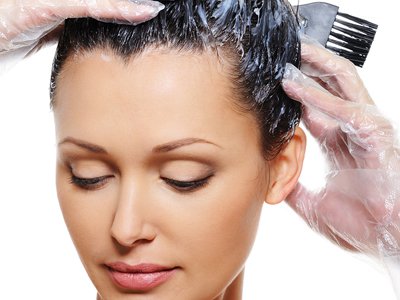What’s worse than cellulite if you care about your looks? Some would say gray hair, judging by the fact that 75 percent of women dye their hair (and so do plenty of men).1 “Hair Coloring/Dying Statistics.” Statistic Brain. http://www.statisticbrain.com/hair-coloring-dying-statistics/ In 2001, customers spent $7 billion in hair color products, and at that time, the industry was expected to grow by 10 percent within five years.2 http://www.economist.com/node/631692 It costs $100 or more every time you have your hair colored at a salon; the ordeal takes hours; the chemicals are toxic; and even with all that, the unseemly little gray roots show themselves within weeks; and so many are desperate for a better solution.
Given those facts, the news that European scientists last year developed a cure for gray hair has plenty of people excited. According to FASEB Journal, an experimental biology publication, there’s a new cream under development called PC-KUS, or pseudocatalase, which reverses the gray when applied topically.3 Alface, Isabel. “Say Bye-Bye to Gray Hair, Researchers Find Way to Reverse the Process.” 3 May 2013. Nature World News. 24 April 2014. http://www.natureworldnews.com/articles/1745/20130503/bye-gray-hair-researchers-find-way-reverse.htm The formula also may reverse a condition called vitiligo in which the skin loses pigment, resulting in discolored and unsightly splotches.
The scientists found that gray hair results when naturally-occurring hydrogen peroxide builds up in hair follicles causing oxidative stress, and ultimately, bleaches out the color. Younger people have an enzyme called catalase that breaks down the hydrogen peroxide into water and oxygen, but that enzyme often stops doing its job as we age. PC-KUS, once activated by exposure to sun, adds new catalase enzymes and converts hydrogen peroxide in the follicle to harmless water and oxygen, thereby blocking it from accumulating in the follicle and skin.4 “Help for Patients with Vigiligo.” Pseudocatalase.com. http://www.pseudocatalase.com/ The result: hair and skin regain their natural pigment.
As distressing as going gray is for so many, losing skin pigment can be far worse. More than two million people in the US suffer from vitiligo. In fact, the original research focused on vitiligo intervention. When the scientists saw that the catalase replacement treatment worked to restore color to skin, they realized it might also work on hair. In the most recent study, the investigators applied the PC-KUS cream to both the skin and eyelashes of 2400 people afflicted with vitiligo. They found that both discolored skin and gray eyelashes responded.
The research is still preliminary and the “cure” isn’t ready for prime-time yet, but scientists are hopeful that a commercial version of the gray-hair remedy is at least on the horizon in the United States. Products purporting to contain PC KUS, are available in Europe and Canada and can be shipped to the US. On another note, it’s still too early to tell if the resulting product will be as toxic as the hair dyes so many slather on every six weeks, but we can hope not. In addition, according to experimental studies, there were no reported side effects or complications. There were a few instances of increased sweating and darkening of skin, which diminished over time despite continuation of use.5 Schallreuter KU, Moore J, Behrens-Williams S, Panske A, Harari M. “Rapid initiation of repigmentation in vitiligo with Dead Sea climatotherapy in combination with pseudocatalase (PC-KUS).”. Int J Dermatol. 2002 Aug;41(8):482-7. http://www.ncbi.nlm.nih.gov/pubmed/12207762 And for perspective, it’s worth keeping in mind that hair-color products are nearly uniformly carcinogenic or harmful in some way, and since the majority of us (women, anyway) will eventually resort to coloring, it would be great to have a non-toxic product.
If, by the way, you doubt that hair-dyes are all that bad, take a look at the Environmental Working Group’s Skin Deep Database ratings for hair color.6 http://www.ewg.org/skindeep/browse/hair+color+and+bleaching/ You’ll notice that once you get past the henna products, it’s all bad news. Very bad news. Given that few salons will touch henna, that means you probably need to do it yourself at home and also, find a henna product that actually covers the gray without huge mess and discomfort. Most don’t.
Or, you can try a natural remedy for gray hair. Jon Barron makes some suggestions in his blog, “Supplementing for Gray Hair,” but note that he also says there are no guarantees that any of the regimens he lists will work for everyone. So far, no solution has come along that works for most people most of the time.
In the meantime, those gray-headed folks who have no interest in using cancer-causing hair dyes and who derive no benefit from natural approaches might take heart to know that a study of wild boars last year found that those boars that go gray have an edge over those that retain their reddish fur.7 Lallania, Marc. “Gray hair cure? Scientists find root cause of discoloration.” 6 May 2013. NBC News. 25 April 2014. http://www.nbcnews.com/health/body-odd/gray-hair-cure-scientists-find-root-cause-discoloration-f6C9802771 Apparently, the gray-haired boars showed less oxidative damage in their cells. The researchers hypothesized that in order to retain the pigmentation in the red fur, the boars used up antioxidants that otherwise would work to eliminate cell-damaging free radicals.8 Live Science Staff. “Why Gray Hair Can Be a Good Thing.” 19 July 2012. Live Scieence. 24 April 2014. http://www.livescience.com/21719-gray-hair-red-hair-health.html
This is significant, according to study director Ismael Galván of the Museo Nacional de Ciencias Naturales in Spain, because “… all higher vertebrates, including humans, share the same types of melanins in skin, hair and plumage…We found that boars showing hair graying were actually those in prime condition and with the lowest levels of oxidative damage.. Far from being a sign of age-related decline, hair graying seems to indicate good condition in wild boars.”
Perhaps Loving Care hair color knew what it was talking about back in the 70’s when they ran a series of commercials that said, “You’re not getting older; you’re getting better.”
References
| ↑1 | “Hair Coloring/Dying Statistics.” Statistic Brain. http://www.statisticbrain.com/hair-coloring-dying-statistics/ |
|---|---|
| ↑2 | http://www.economist.com/node/631692 |
| ↑3 | Alface, Isabel. “Say Bye-Bye to Gray Hair, Researchers Find Way to Reverse the Process.” 3 May 2013. Nature World News. 24 April 2014. http://www.natureworldnews.com/articles/1745/20130503/bye-gray-hair-researchers-find-way-reverse.htm |
| ↑4 | “Help for Patients with Vigiligo.” Pseudocatalase.com. http://www.pseudocatalase.com/ |
| ↑5 | Schallreuter KU, Moore J, Behrens-Williams S, Panske A, Harari M. “Rapid initiation of repigmentation in vitiligo with Dead Sea climatotherapy in combination with pseudocatalase (PC-KUS).”. Int J Dermatol. 2002 Aug;41(8):482-7. http://www.ncbi.nlm.nih.gov/pubmed/12207762 |
| ↑6 | http://www.ewg.org/skindeep/browse/hair+color+and+bleaching/ |
| ↑7 | Lallania, Marc. “Gray hair cure? Scientists find root cause of discoloration.” 6 May 2013. NBC News. 25 April 2014. http://www.nbcnews.com/health/body-odd/gray-hair-cure-scientists-find-root-cause-discoloration-f6C9802771 |
| ↑8 | Live Science Staff. “Why Gray Hair Can Be a Good Thing.” 19 July 2012. Live Scieence. 24 April 2014. http://www.livescience.com/21719-gray-hair-red-hair-health.html |












Happy to know that atlast
Happy to know that atlast some one find a solution for grey hair..! But I wish to know when it wil be come to matket.
Is this product really works
Is this product really works for gray hair? it turns gray hair to black or just control over it??
I’m use PC KUs OVER 6 month.
I’m use PC KUs OVER 6 month. Looks like it work. But very slow for me and you need a sun. Some old gray hairs go dark . But for this long time I get new gray hairs. In my situation PC KUS doesn’t stop graying. I getting new gray hairs after sex.
Since this PC KU is a topical
Since this PC KU is a topical product it would only help control graying hair with continuous use. Like they say in the article above……”will it be any safer than hair dye products??”
Still sounds like a band-aid instead of a great solution. Taking some form of enzyme supplement with Catalase internally to correct depletion as we age would be better than a topical product, but again, it would be something you would have to continually supplement with to retain the effects. I would most likely choose an oral enzyme supplement myself.
I don’t use store hair dye. I do use Henna and Indigo and there are pros and cons to this. It is messy and takes longer to do the whole process but if you find a good company that sells USDA Certified Organic and is guaranteed to not contain lead, pesticides or PPD it is worth it. There are different Henna and Indigo variations and they come from different regions. Some cover gray better than others. I can go 5 months easily before I have to do mine again.
Of course, if I found a great enzyme supplement with Catalase that was shown to at least slow the graying process significantly, I would buy it, but I would still use Henna and Indigo on my hair as well.